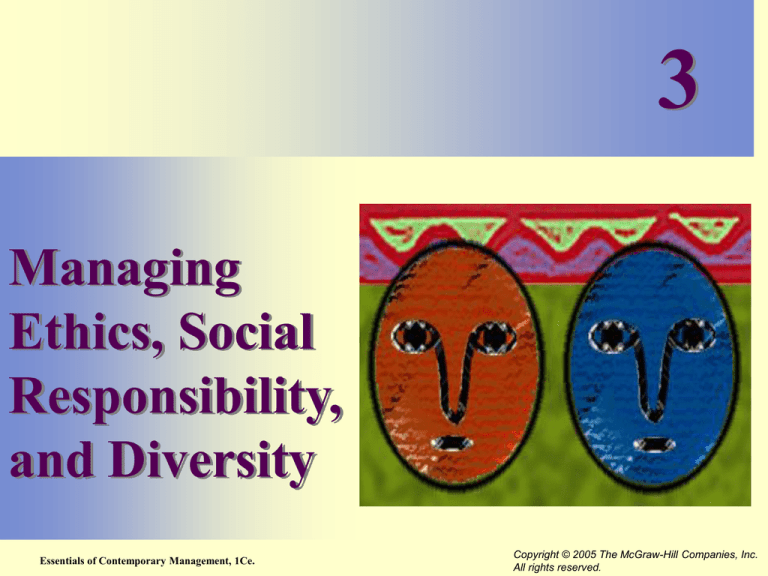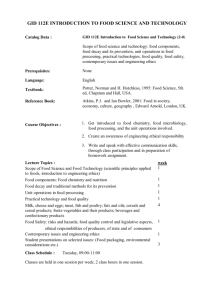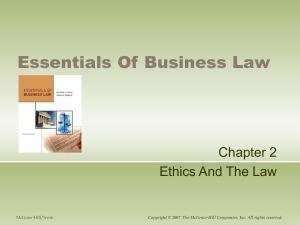
3-1
3
Managing
Ethics, Social
Responsibility,
and Diversity
Essentials of Contemporary Management, 1Ce.
Copyright © 2005 The McGraw-Hill Companies, Inc.
All rights reserved.
3-2
Learning Objectives
1. Describe the concept of ethics, and the different models
of ethics.
2. Describe the concept of social responsibility and detail
the ways in which organizations can encourage both ethical
and socially responsible behaviour among their employees.
2. Define diversity, and explain why the effective
management of diverse employees is both an ethical issue
and a means for an organization to improve its
performance.
3. Identify instances of sexual harassment, and discuss
how to prevent its occurrence.
Essentials of Contemporary Management, 1Ce.
Copyright © 2005 The McGraw-Hill Companies, Inc.
All rights reserved.
3-3
Ethics
It is difficult to know when a decision is
ethical. Here is a good test:
Managerial ethics: If a manager makes a
decision falling within usual standards, is
willing to personally communicate the
decision to stakeholders, and believes
friends would approve, then it is likely an
ethical decision.
Essentials of Contemporary Management, 1Ce.
Copyright © 2005 The McGraw-Hill Companies, Inc.
All rights reserved.
3-4
Ethical Models
Utilitarian
Model: An ethical decision is a decision that
produces the greatest good for the greatest number of people.
Moral Rights Model: An ethical decision is a decision that
best maintains and protects the fundamental rights and
privileges of the people affected by it. For example, ethical
decisions protect people’s rights to freedom, life and safety,
privacy, free speech, and freedom of conscience.
Justice Model: An ethical decision is a decision that
distributes benefits and harms among stakeholders in a fair,
equitable, or impartial way.
Essentials of Contemporary Management, 1Ce.
Copyright © 2005 The McGraw-Hill Companies, Inc.
All rights reserved.
3-5
Figure 3.1 Sources of an
Organization’s Code of Ethics
Essentials of Contemporary Management, 1Ce.
Copyright © 2005 The McGraw-Hill Companies, Inc.
All rights reserved.
3-6
Ethics and Stakeholders
Stakeholders:
people or groups that have an
interest in the organization.
Stakeholders include employees, customers, shareholders,
suppliers, and others.
Stakeholders often want different outcomes and managers must
work to satisfy as many as possible.
Ethics:
a set of beliefs about right and wrong.
Ethics guide people in dealings with stakeholders and others, to
determine appropriate actions.
Managers often must choose between the conflicting interest of
stakeholders.
Essentials of Contemporary Management, 1Ce.
Copyright © 2005 The McGraw-Hill Companies, Inc.
All rights reserved.
3-7
Ethical Origins
Societal
Ethics: standards that members of society
use when dealing with each other.
Based on values and standards found in society’s legal rules,
norm, and mores.
Codified in the form of law and society customs.
Norms dictate how people should behave.
Societal
ethics vary based on a given society.
Strong beliefs in one country may differ elsewhere.
Example: bribes are an accepted business practice in some
countries.
Essentials of Contemporary Management, 1Ce.
Copyright © 2005 The McGraw-Hill Companies, Inc.
All rights reserved.
3-8
Ethical Origins
Professional
ethics: values and standards used
by groups of managers in the workplace.
Applied when decisions are not clear-cut ethically.
Example: physicians and lawyers have professional
associations that enforce these.
Individual
ethics: values of an individual
resulting from their family& upbringing.
If behaviour is not illegal, people will often disagree on if
it is ethical.
Ethics of top managers set the tone for firms.
Essentials of Contemporary Management, 1Ce.
Copyright © 2005 The McGraw-Hill Companies, Inc.
All rights reserved.
3-9
Ethical Decisions
A key
ethical issue is how to disperse harm and
benefits among stakeholders.
If a firm is very profitable for two years, who should receive the
profits? Employees, managers and stockholders all want a share.
Should we keep the cash for future slowdowns?
What is the ethical decision?
What
about the reverse, when firms must layoff
workers.
Final point: stockholders are the legal owners of the
firm!
Essentials of Contemporary Management, 1Ce.
Copyright © 2005 The McGraw-Hill Companies, Inc.
All rights reserved.
3-10
Ethical Decisions
Some
other issues managers must consider.
Should you hold payment to suppliers as long as
possible to benefit your firm?
This will harm your supplier who is a stakeholder.
Should you pay severance pay to laid off workers?
This may decrease the stockholder's return.
Should you buy goods from overseas firms that hire
children?
If you don’t the children might not earn enough
money to eat.
Essentials of Contemporary Management, 1Ce.
Copyright © 2005 The McGraw-Hill Companies, Inc.
All rights reserved.
3-11
Promoting Ethics
There
is evidence showing that ethical managers
benefit over the long run.
Ethical Control System: a formal system to
encourage ethical management.
Firms appoint an ethics ombudsman to monitor practices.
Ombudsman communicates standards to all employees.
Ethical
culture: firms increasingly seek to make good
ethics part of the norm and organizational culture.
Essentials of Contemporary Management, 1Ce.
Copyright © 2005 The McGraw-Hill Companies, Inc.
All rights reserved.
3-12
Social Responsibility
Responsibility: the manager’s duty to
nurture, protect and enhance the welfare of
stakeholders.
Social
Essentials of Contemporary Management, 1Ce.
Copyright © 2005 The McGraw-Hill Companies, Inc.
All rights reserved.
3-13
Table 3.2 Forms of Socially Responsible Behaviour
Managers are being socially responsible and showing their support for their
stakeholders when they:
Provide severance payments to help laid-off workers make ends meet until they can
find another job.
Provide workers with opportunities to enhance their skills and acquire additional
education so they can remain productive and do not become obsolete because of
changes in technology.
Allow employees to take time off when they need to and provide extended health care
and pension benefits for employees.
Contribute to charities or support various civic-minded activities in the cities or towns
in which they are located.
Decide to keep open a factory whose closure would devastate the local community.
Decide to keep a company’s operations in Canada to protect the jobs of Canadian
workers rather than move abroad.
Decide to spend money to improve a new factory so that it will not pollute the
environment.
Decline to invest in countries that have poor human rights records.
Choose to help poor countries develop an economic base to improve living standards.
Essentials of Contemporary Management, 1Ce.
Copyright © 2005 The McGraw-Hill Companies, Inc.
All rights reserved.
3-14
Figure 3.2 Approaches to Social
Responsibility
Essentials of Contemporary Management, 1Ce.
Copyright © 2005 The McGraw-Hill Companies, Inc.
All rights reserved.
3-15
Approaches to Social
Responsibility
There are many ways managers respond to this duty:
Obstructionist approach: managers choose not to be
socially responsible.
Managers behave illegally and unethically.
They hide and cover-up problems.
Defensive
approach: managers stay within the law
but make no attempt to exercise additional social
responsibility.
Put shareholder interest above all other stakeholders.
Managers say society should make laws if change is needed.
Essentials of Contemporary Management, 1Ce.
Copyright © 2005 The McGraw-Hill Companies, Inc.
All rights reserved.
3-16
Approaches to Social Responsibility
Accommodative approach: managers realize the
need for social responsibility.
Try to balance the interests of all stakeholders.
Proactive
approach: managers actively
embrace social responsibility.
Go out of their way to learn about and help stakeholders.
Essentials of Contemporary Management, 1Ce.
Copyright © 2005 The McGraw-Hill Companies, Inc.
All rights reserved.
3-17
Why Be Socially Responsible?
Managers
accrue benefits by being
responsible.
Workers and society benefit.
Quality of life in society will improve.
It is the right thing to do.
Whistleblowers:
a person reporting illegal or
unethical acts.
Whistleblowers now protected by law in most cases.
Social
audit: managers specifically take ethics
and business into account when making
decisions.
Essentials of Contemporary Management, 1Ce.
Copyright © 2005 The McGraw-Hill Companies, Inc.
All rights reserved.
3-18
Managing A Diverse Workforce
The
workforce has become much more
diverse during the last 30 years.
Diversity refers to differences among people such as age,
gender, race, religion.
Diversity is an ethical and social responsibility issue.
Managers
need to give all workers equal
opportunities.
Not following this is against the law and unethical.
When all have equal opportunity, the organization
benefits.
Essentials of Contemporary Management, 1Ce.
Copyright © 2005 The McGraw-Hill Companies, Inc.
All rights reserved.
3-19
Figure 3.3 Sources of Diversity
Essentials of Contemporary Management, 1Ce.
Copyright © 2005 The McGraw-Hill Companies, Inc.
All rights reserved.
3-20
Manage Diversity Effectively
Distributive
Justice: dictates members be
treated fairly concerning pay raises,
promotions, office space and similar issues.
These rewards should be assigned based on merit and
performance.
A legal requirement that is becoming more prevalent in
American business.
Procedural
Justice: Managers should use fair
practices to determine how to distribute
outcomes to members.
This involves how managers appraise worker
performance or decide who to layoff.
Essentials of Contemporary Management, 1Ce.
Copyright © 2005 The McGraw-Hill Companies, Inc.
All rights reserved.
3-21
Effectively Managing Diversity
Makes Good Legal Sense
Canadian
Human Rights Act: against the law for federal
employers to discriminate on the basis of race, national
or ethnic origin, colour, religion, age, sex (including
pregnancy and childbirth), marital status, family status,
mental or physical disability (including previous or
present drug or alcohol dependence), pardoned
conviction, or sexual orientation
Employment Equity Act: Four protected categories
Aboriginal peoples
Persons with disabilities
Members of visible minorities
Women
Essentials of Contemporary Management, 1Ce.
Copyright © 2005 The McGraw-Hill Companies, Inc.
All rights reserved.
3-22
Diversity Makes Business Sense
Diverse
employees provide new, different points of
view.
Customers are also diverse.
Still,
some employees may be treated unfairly.
Biases: systematic tendencies to use information in ways that result
in inaccurate perceptions.
People often view those like themselves positively and have biases
about others.
Social status is a type of bias conferred to people of differing social
position.
Stereotypes: inaccurate beliefs about a given group.
Essentials of Contemporary Management, 1Ce.
Copyright © 2005 The McGraw-Hill Companies, Inc.
All rights reserved.
3-23
How to Manage Diversity
Increase
diversity awareness: managers need
to become aware of their own bias.
Understand cultural differences and their
impact on working styles.
Practice effective communication with diverse
groups.
Be sure top management is committed to
diversity.
Essentials of Contemporary Management, 1Ce.
Copyright © 2005 The McGraw-Hill Companies, Inc.
All rights reserved.
3-24
Sexual Harassment
Damages
both the person being harassed and
the organization.
Both men and women can be victims.
Quid
pro quo harassment: victim is requested
to perform sexual favors to keep a job or win
promotion.
Hostile work environment harassment: Some
members are faced with a hostile,
intimidating work environment.
Lewd jokes, pornographic displays and remarks.
Essentials of Contemporary Management, 1Ce.
Copyright © 2005 The McGraw-Hill Companies, Inc.
All rights reserved.
3-25
Avoiding Harassment
Develop
and communicate a sexual
harassment policy.
Point out that these actions are unacceptable.
Set
up a fair complaint system to investigate
allegations.
If there are problems, correct them at once.
Provide
harassment training to employees and
managers.
Essentials of Contemporary Management, 1Ce.
Copyright © 2005 The McGraw-Hill Companies, Inc.
All rights reserved.






